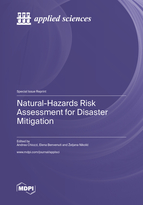Natural-Hazards Risk Assessment for Disaster Mitigation
A special issue of Applied Sciences (ISSN 2076-3417). This special issue belongs to the section "Earth Sciences".
Deadline for manuscript submissions: closed (31 October 2022) | Viewed by 46006
Special Issue Editors
Interests: computational mechanics; finite element methods; virtual element methods; masonry; masonry structures; limit analysis; structural fragility; earthquake engineering
Special Issues, Collections and Topics in MDPI journals
Interests: solid and structural mechanics
Special Issue Information
Dear Colleagues,
Knowledge and awareness of risks related to natural hazards are essential requirements for the enhancement of the community's resilience to disasters. According to the Sendai Framework for Disaster Risk Reduction 2015–2030, it is crucial to take actions that allow us to anticipate, manage, and mitigate disaster risks in order to more effectively reduce their economic and social impact and protect health, socioeconomic assets, cultural heritage and ecosystems of communities and countries. While the increasing occurrence of disasters related to meteorological hazards, such as floods, storms, and droughts, can be directly attributed to the consequences of climate change, an increase in the number of geophysical disasters, such as those due to earthquakes and tsunamis, is also observed without any evidence of an increment in the frequencies of occurrence of these natural phenomena. Hence, other human-related agents that are responsible for the increment of risk exposure and community vulnerability have to be factored in, such as land misuse in densely populated areas and in coastal zones.
This Special Issue of Applied Sciences addresses concepts, methods, and techniques for the natural hazards risk assessment including, but not limited to, floods, earthquakes and meteotsunamis.
Topics of interest include:
- Quantitative, semi-quantitative, and qualitative methods for the assessment of risk related to natural hazards;
- Risk analysis at different scales;
- Multi-hazard risk assessment techniques;
- Real-time hazard monitoring and warning systems;
- Disaster mitigation strategies;
- Risk management and emergency planning at multiple scales
Dr. Andrea Chiozzi
Dr. Elena Benvenuti
Prof. Dr. Željana Nikolić
Guest Editors
Manuscript Submission Information
Manuscripts should be submitted online at www.mdpi.com by registering and logging in to this website. Once you are registered, click here to go to the submission form. Manuscripts can be submitted until the deadline. All submissions that pass pre-check are peer-reviewed. Accepted papers will be published continuously in the journal (as soon as accepted) and will be listed together on the special issue website. Research articles, review articles as well as short communications are invited. For planned papers, a title and short abstract (about 100 words) can be sent to the Editorial Office for announcement on this website.
Submitted manuscripts should not have been published previously, nor be under consideration for publication elsewhere (except conference proceedings papers). All manuscripts are thoroughly refereed through a single-blind peer-review process. A guide for authors and other relevant information for submission of manuscripts is available on the Instructions for Authors page. Applied Sciences is an international peer-reviewed open access semimonthly journal published by MDPI.
Please visit the Instructions for Authors page before submitting a manuscript. The Article Processing Charge (APC) for publication in this open access journal is 2400 CHF (Swiss Francs). Submitted papers should be well formatted and use good English. Authors may use MDPI's English editing service prior to publication or during author revisions.
Keywords
- natural hazards
- hazard assessment
- multi-hazard assessment
- risk analysis
- risk management
- disaster mitigation








